Impact of Disruptive Innovation on Business Development Strategies
VerifiedAdded on 2020/03/28
|8
|2596
|99
Essay
AI Summary
This essay delves into the concept of disruptive innovation and its impact on business development. It begins by defining key terms such as business models and disruptive innovation, highlighting how startups often drive change while established players may be hesitant. The essay explores the reasons behind this, including established players' focus on high-end customers, risk aversion, and adherence to traditional thinking. The second part of the essay examines the evolution of online banking, from its early stages to the present, discussing the factors that have led to its adoption and disruption in the banking sector. It analyzes why some banks adopted online banking as a separate unit while others integrated it into their existing models. The essay concludes by emphasizing the importance of embracing change and adapting to disruptive innovations for the betterment of the industry and society, using examples like Uber, Amazon, and Netflix. The essay is a valuable resource for students seeking to understand the dynamics of business innovation and development.
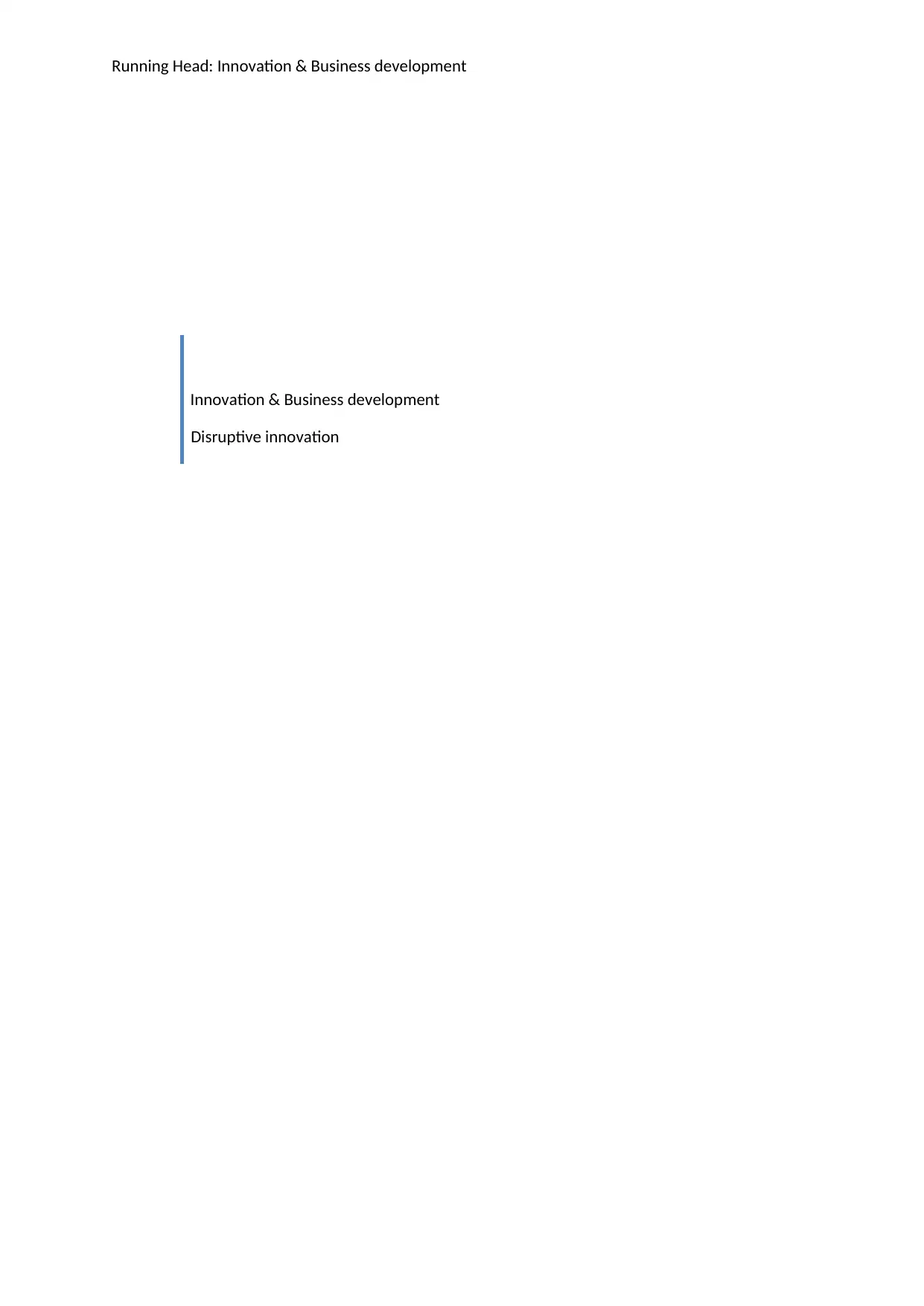
Running Head: Innovation & Business development
Innovation & Business development
Disruptive innovation
Innovation & Business development
Disruptive innovation
Paraphrase This Document
Need a fresh take? Get an instant paraphrase of this document with our AI Paraphraser
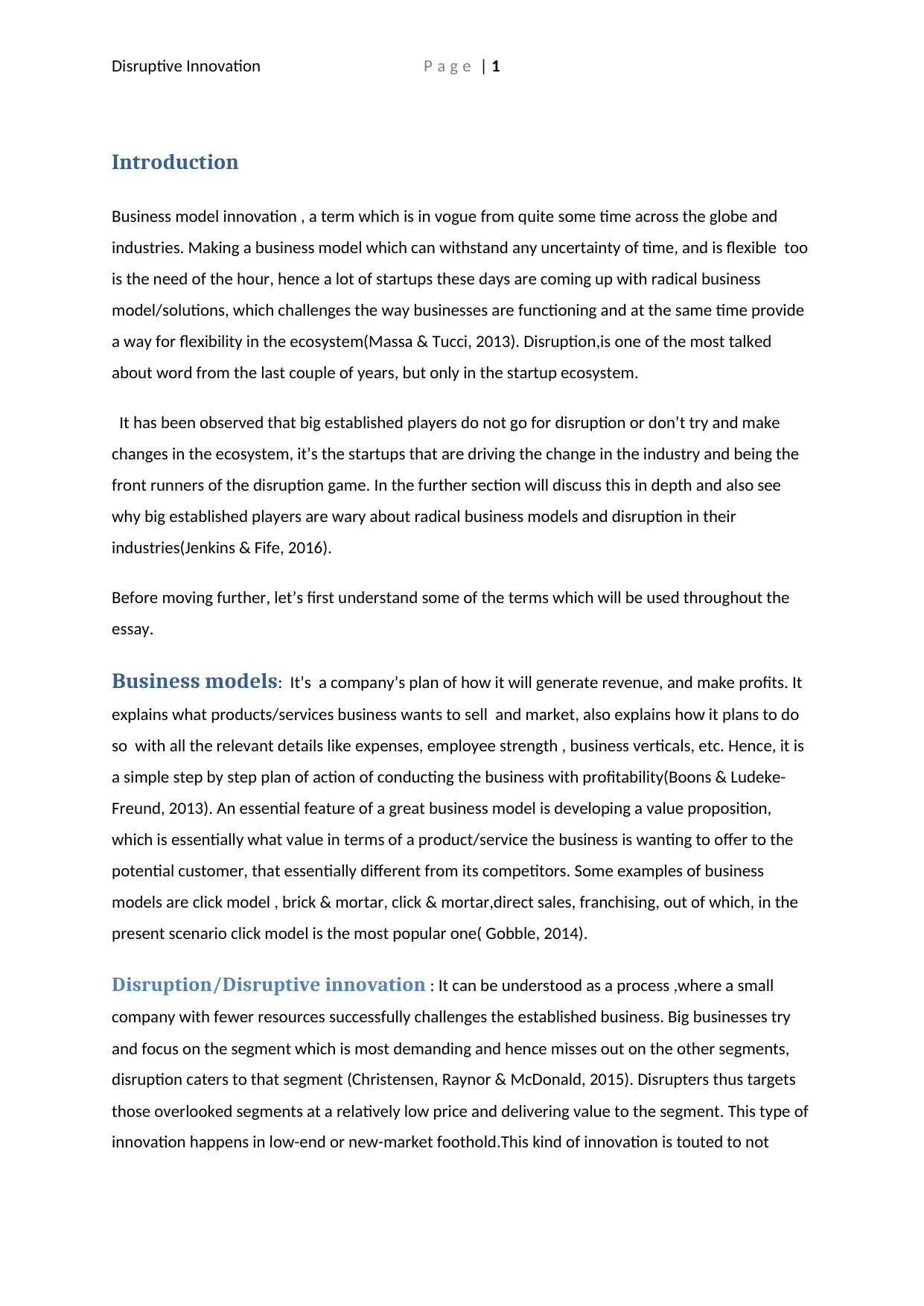
Disruptive Innovation P a g e | 1
Introduction
Business model innovation , a term which is in vogue from quite some time across the globe and
industries. Making a business model which can withstand any uncertainty of time, and is flexible too
is the need of the hour, hence a lot of startups these days are coming up with radical business
model/solutions, which challenges the way businesses are functioning and at the same time provide
a way for flexibility in the ecosystem(Massa & Tucci, 2013). Disruption,is one of the most talked
about word from the last couple of years, but only in the startup ecosystem.
It has been observed that big established players do not go for disruption or don’t try and make
changes in the ecosystem, it’s the startups that are driving the change in the industry and being the
front runners of the disruption game. In the further section will discuss this in depth and also see
why big established players are wary about radical business models and disruption in their
industries(Jenkins & Fife, 2016).
Before moving further, let’s first understand some of the terms which will be used throughout the
essay.
Business models: It’s a company’s plan of how it will generate revenue, and make profits. It
explains what products/services business wants to sell and market, also explains how it plans to do
so with all the relevant details like expenses, employee strength , business verticals, etc. Hence, it is
a simple step by step plan of action of conducting the business with profitability(Boons & Ludeke-
Freund, 2013). An essential feature of a great business model is developing a value proposition,
which is essentially what value in terms of a product/service the business is wanting to offer to the
potential customer, that essentially different from its competitors. Some examples of business
models are click model , brick & mortar, click & mortar,direct sales, franchising, out of which, in the
present scenario click model is the most popular one( Gobble, 2014).
Disruption/Disruptive innovation : It can be understood as a process ,where a small
company with fewer resources successfully challenges the established business. Big businesses try
and focus on the segment which is most demanding and hence misses out on the other segments,
disruption caters to that segment (Christensen, Raynor & McDonald, 2015). Disrupters thus targets
those overlooked segments at a relatively low price and delivering value to the segment. This type of
innovation happens in low-end or new-market foothold.This kind of innovation is touted to not
Introduction
Business model innovation , a term which is in vogue from quite some time across the globe and
industries. Making a business model which can withstand any uncertainty of time, and is flexible too
is the need of the hour, hence a lot of startups these days are coming up with radical business
model/solutions, which challenges the way businesses are functioning and at the same time provide
a way for flexibility in the ecosystem(Massa & Tucci, 2013). Disruption,is one of the most talked
about word from the last couple of years, but only in the startup ecosystem.
It has been observed that big established players do not go for disruption or don’t try and make
changes in the ecosystem, it’s the startups that are driving the change in the industry and being the
front runners of the disruption game. In the further section will discuss this in depth and also see
why big established players are wary about radical business models and disruption in their
industries(Jenkins & Fife, 2016).
Before moving further, let’s first understand some of the terms which will be used throughout the
essay.
Business models: It’s a company’s plan of how it will generate revenue, and make profits. It
explains what products/services business wants to sell and market, also explains how it plans to do
so with all the relevant details like expenses, employee strength , business verticals, etc. Hence, it is
a simple step by step plan of action of conducting the business with profitability(Boons & Ludeke-
Freund, 2013). An essential feature of a great business model is developing a value proposition,
which is essentially what value in terms of a product/service the business is wanting to offer to the
potential customer, that essentially different from its competitors. Some examples of business
models are click model , brick & mortar, click & mortar,direct sales, franchising, out of which, in the
present scenario click model is the most popular one( Gobble, 2014).
Disruption/Disruptive innovation : It can be understood as a process ,where a small
company with fewer resources successfully challenges the established business. Big businesses try
and focus on the segment which is most demanding and hence misses out on the other segments,
disruption caters to that segment (Christensen, Raynor & McDonald, 2015). Disrupters thus targets
those overlooked segments at a relatively low price and delivering value to the segment. This type of
innovation happens in low-end or new-market foothold.This kind of innovation is touted to not
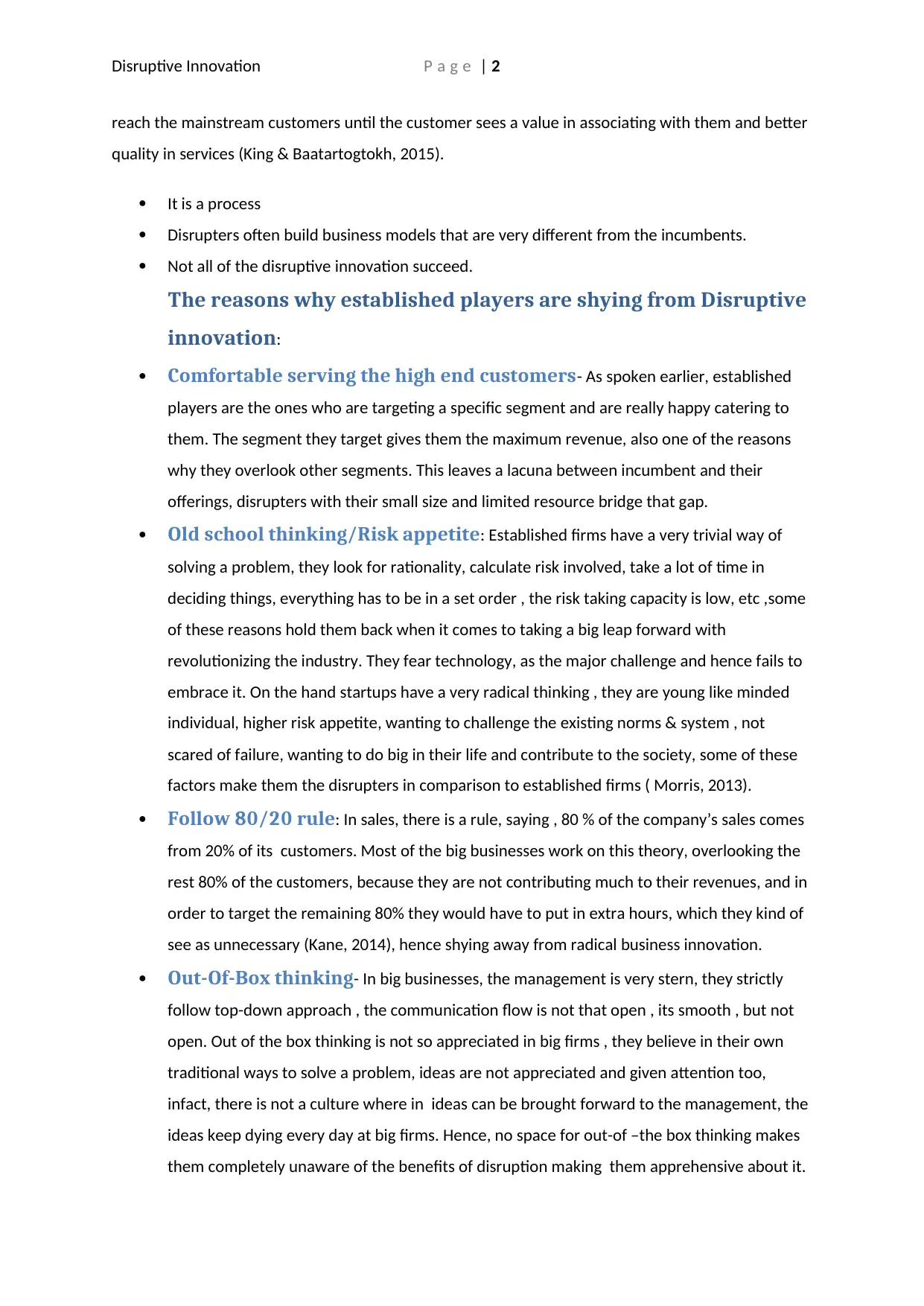
Disruptive Innovation P a g e | 2
reach the mainstream customers until the customer sees a value in associating with them and better
quality in services (King & Baatartogtokh, 2015).
It is a process
Disrupters often build business models that are very different from the incumbents.
Not all of the disruptive innovation succeed.
The reasons why established players are shying from Disruptive
innovation:
Comfortable serving the high end customers- As spoken earlier, established
players are the ones who are targeting a specific segment and are really happy catering to
them. The segment they target gives them the maximum revenue, also one of the reasons
why they overlook other segments. This leaves a lacuna between incumbent and their
offerings, disrupters with their small size and limited resource bridge that gap.
Old school thinking/Risk appetite: Established firms have a very trivial way of
solving a problem, they look for rationality, calculate risk involved, take a lot of time in
deciding things, everything has to be in a set order , the risk taking capacity is low, etc ,some
of these reasons hold them back when it comes to taking a big leap forward with
revolutionizing the industry. They fear technology, as the major challenge and hence fails to
embrace it. On the hand startups have a very radical thinking , they are young like minded
individual, higher risk appetite, wanting to challenge the existing norms & system , not
scared of failure, wanting to do big in their life and contribute to the society, some of these
factors make them the disrupters in comparison to established firms ( Morris, 2013).
Follow 80/20 rule: In sales, there is a rule, saying , 80 % of the company’s sales comes
from 20% of its customers. Most of the big businesses work on this theory, overlooking the
rest 80% of the customers, because they are not contributing much to their revenues, and in
order to target the remaining 80% they would have to put in extra hours, which they kind of
see as unnecessary (Kane, 2014), hence shying away from radical business innovation.
Out-Of-Box thinking- In big businesses, the management is very stern, they strictly
follow top-down approach , the communication flow is not that open , its smooth , but not
open. Out of the box thinking is not so appreciated in big firms , they believe in their own
traditional ways to solve a problem, ideas are not appreciated and given attention too,
infact, there is not a culture where in ideas can be brought forward to the management, the
ideas keep dying every day at big firms. Hence, no space for out-of –the box thinking makes
them completely unaware of the benefits of disruption making them apprehensive about it.
reach the mainstream customers until the customer sees a value in associating with them and better
quality in services (King & Baatartogtokh, 2015).
It is a process
Disrupters often build business models that are very different from the incumbents.
Not all of the disruptive innovation succeed.
The reasons why established players are shying from Disruptive
innovation:
Comfortable serving the high end customers- As spoken earlier, established
players are the ones who are targeting a specific segment and are really happy catering to
them. The segment they target gives them the maximum revenue, also one of the reasons
why they overlook other segments. This leaves a lacuna between incumbent and their
offerings, disrupters with their small size and limited resource bridge that gap.
Old school thinking/Risk appetite: Established firms have a very trivial way of
solving a problem, they look for rationality, calculate risk involved, take a lot of time in
deciding things, everything has to be in a set order , the risk taking capacity is low, etc ,some
of these reasons hold them back when it comes to taking a big leap forward with
revolutionizing the industry. They fear technology, as the major challenge and hence fails to
embrace it. On the hand startups have a very radical thinking , they are young like minded
individual, higher risk appetite, wanting to challenge the existing norms & system , not
scared of failure, wanting to do big in their life and contribute to the society, some of these
factors make them the disrupters in comparison to established firms ( Morris, 2013).
Follow 80/20 rule: In sales, there is a rule, saying , 80 % of the company’s sales comes
from 20% of its customers. Most of the big businesses work on this theory, overlooking the
rest 80% of the customers, because they are not contributing much to their revenues, and in
order to target the remaining 80% they would have to put in extra hours, which they kind of
see as unnecessary (Kane, 2014), hence shying away from radical business innovation.
Out-Of-Box thinking- In big businesses, the management is very stern, they strictly
follow top-down approach , the communication flow is not that open , its smooth , but not
open. Out of the box thinking is not so appreciated in big firms , they believe in their own
traditional ways to solve a problem, ideas are not appreciated and given attention too,
infact, there is not a culture where in ideas can be brought forward to the management, the
ideas keep dying every day at big firms. Hence, no space for out-of –the box thinking makes
them completely unaware of the benefits of disruption making them apprehensive about it.
⊘ This is a preview!⊘
Do you want full access?
Subscribe today to unlock all pages.

Trusted by 1+ million students worldwide
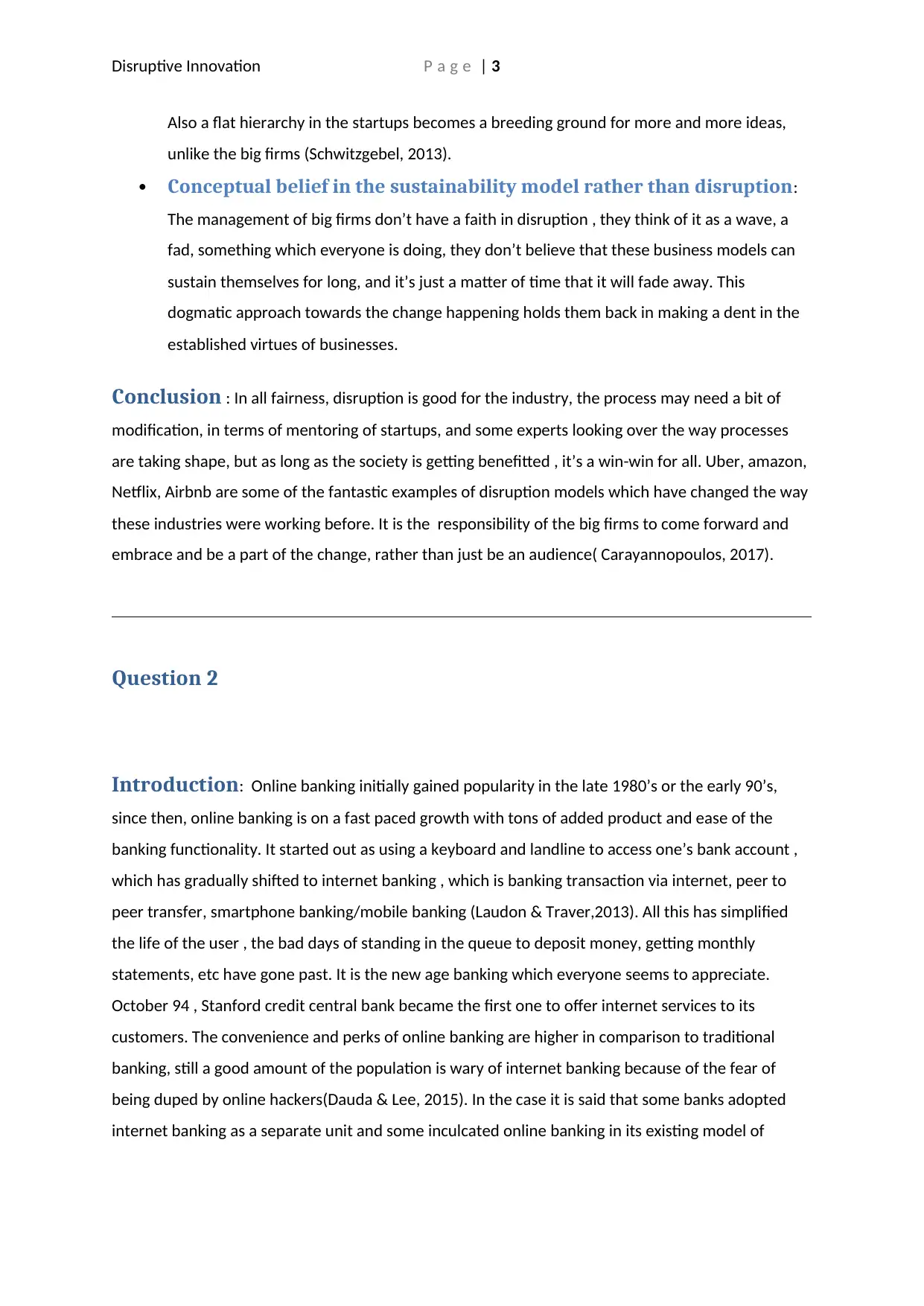
Disruptive Innovation P a g e | 3
Also a flat hierarchy in the startups becomes a breeding ground for more and more ideas,
unlike the big firms (Schwitzgebel, 2013).
Conceptual belief in the sustainability model rather than disruption:
The management of big firms don’t have a faith in disruption , they think of it as a wave, a
fad, something which everyone is doing, they don’t believe that these business models can
sustain themselves for long, and it’s just a matter of time that it will fade away. This
dogmatic approach towards the change happening holds them back in making a dent in the
established virtues of businesses.
Conclusion : In all fairness, disruption is good for the industry, the process may need a bit of
modification, in terms of mentoring of startups, and some experts looking over the way processes
are taking shape, but as long as the society is getting benefitted , it’s a win-win for all. Uber, amazon,
Netflix, Airbnb are some of the fantastic examples of disruption models which have changed the way
these industries were working before. It is the responsibility of the big firms to come forward and
embrace and be a part of the change, rather than just be an audience( Carayannopoulos, 2017).
Question 2
Introduction: Online banking initially gained popularity in the late 1980’s or the early 90’s,
since then, online banking is on a fast paced growth with tons of added product and ease of the
banking functionality. It started out as using a keyboard and landline to access one’s bank account ,
which has gradually shifted to internet banking , which is banking transaction via internet, peer to
peer transfer, smartphone banking/mobile banking (Laudon & Traver,2013). All this has simplified
the life of the user , the bad days of standing in the queue to deposit money, getting monthly
statements, etc have gone past. It is the new age banking which everyone seems to appreciate.
October 94 , Stanford credit central bank became the first one to offer internet services to its
customers. The convenience and perks of online banking are higher in comparison to traditional
banking, still a good amount of the population is wary of internet banking because of the fear of
being duped by online hackers(Dauda & Lee, 2015). In the case it is said that some banks adopted
internet banking as a separate unit and some inculcated online banking in its existing model of
Also a flat hierarchy in the startups becomes a breeding ground for more and more ideas,
unlike the big firms (Schwitzgebel, 2013).
Conceptual belief in the sustainability model rather than disruption:
The management of big firms don’t have a faith in disruption , they think of it as a wave, a
fad, something which everyone is doing, they don’t believe that these business models can
sustain themselves for long, and it’s just a matter of time that it will fade away. This
dogmatic approach towards the change happening holds them back in making a dent in the
established virtues of businesses.
Conclusion : In all fairness, disruption is good for the industry, the process may need a bit of
modification, in terms of mentoring of startups, and some experts looking over the way processes
are taking shape, but as long as the society is getting benefitted , it’s a win-win for all. Uber, amazon,
Netflix, Airbnb are some of the fantastic examples of disruption models which have changed the way
these industries were working before. It is the responsibility of the big firms to come forward and
embrace and be a part of the change, rather than just be an audience( Carayannopoulos, 2017).
Question 2
Introduction: Online banking initially gained popularity in the late 1980’s or the early 90’s,
since then, online banking is on a fast paced growth with tons of added product and ease of the
banking functionality. It started out as using a keyboard and landline to access one’s bank account ,
which has gradually shifted to internet banking , which is banking transaction via internet, peer to
peer transfer, smartphone banking/mobile banking (Laudon & Traver,2013). All this has simplified
the life of the user , the bad days of standing in the queue to deposit money, getting monthly
statements, etc have gone past. It is the new age banking which everyone seems to appreciate.
October 94 , Stanford credit central bank became the first one to offer internet services to its
customers. The convenience and perks of online banking are higher in comparison to traditional
banking, still a good amount of the population is wary of internet banking because of the fear of
being duped by online hackers(Dauda & Lee, 2015). In the case it is said that some banks adopted
internet banking as a separate unit and some inculcated online banking in its existing model of
Paraphrase This Document
Need a fresh take? Get an instant paraphrase of this document with our AI Paraphraser
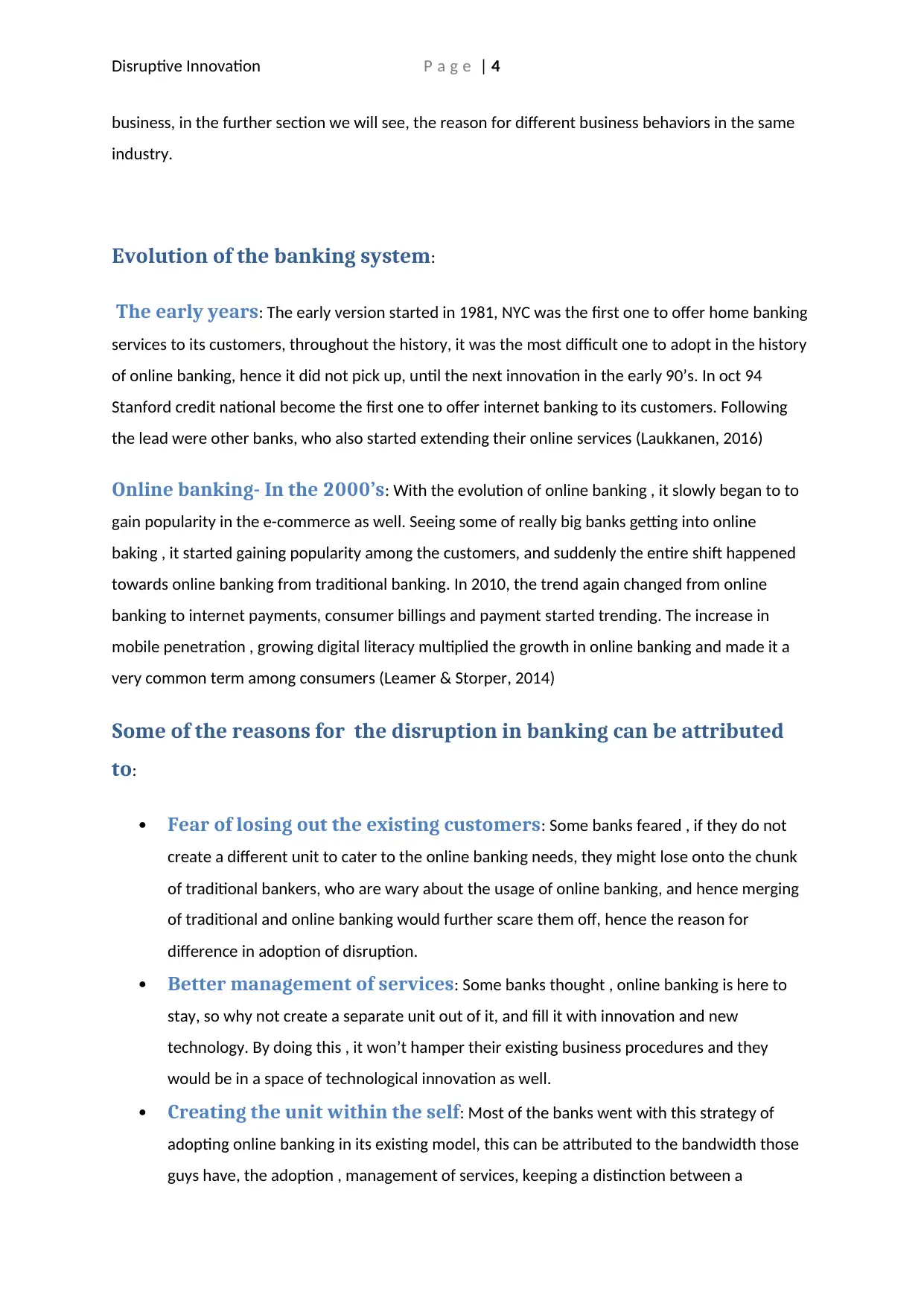
Disruptive Innovation P a g e | 4
business, in the further section we will see, the reason for different business behaviors in the same
industry.
Evolution of the banking system:
The early years: The early version started in 1981, NYC was the first one to offer home banking
services to its customers, throughout the history, it was the most difficult one to adopt in the history
of online banking, hence it did not pick up, until the next innovation in the early 90’s. In oct 94
Stanford credit national become the first one to offer internet banking to its customers. Following
the lead were other banks, who also started extending their online services (Laukkanen, 2016)
Online banking- In the 2000’s: With the evolution of online banking , it slowly began to to
gain popularity in the e-commerce as well. Seeing some of really big banks getting into online
baking , it started gaining popularity among the customers, and suddenly the entire shift happened
towards online banking from traditional banking. In 2010, the trend again changed from online
banking to internet payments, consumer billings and payment started trending. The increase in
mobile penetration , growing digital literacy multiplied the growth in online banking and made it a
very common term among consumers (Leamer & Storper, 2014)
Some of the reasons for the disruption in banking can be attributed
to:
Fear of losing out the existing customers: Some banks feared , if they do not
create a different unit to cater to the online banking needs, they might lose onto the chunk
of traditional bankers, who are wary about the usage of online banking, and hence merging
of traditional and online banking would further scare them off, hence the reason for
difference in adoption of disruption.
Better management of services: Some banks thought , online banking is here to
stay, so why not create a separate unit out of it, and fill it with innovation and new
technology. By doing this , it won’t hamper their existing business procedures and they
would be in a space of technological innovation as well.
Creating the unit within the self: Most of the banks went with this strategy of
adopting online banking in its existing model, this can be attributed to the bandwidth those
guys have, the adoption , management of services, keeping a distinction between a
business, in the further section we will see, the reason for different business behaviors in the same
industry.
Evolution of the banking system:
The early years: The early version started in 1981, NYC was the first one to offer home banking
services to its customers, throughout the history, it was the most difficult one to adopt in the history
of online banking, hence it did not pick up, until the next innovation in the early 90’s. In oct 94
Stanford credit national become the first one to offer internet banking to its customers. Following
the lead were other banks, who also started extending their online services (Laukkanen, 2016)
Online banking- In the 2000’s: With the evolution of online banking , it slowly began to to
gain popularity in the e-commerce as well. Seeing some of really big banks getting into online
baking , it started gaining popularity among the customers, and suddenly the entire shift happened
towards online banking from traditional banking. In 2010, the trend again changed from online
banking to internet payments, consumer billings and payment started trending. The increase in
mobile penetration , growing digital literacy multiplied the growth in online banking and made it a
very common term among consumers (Leamer & Storper, 2014)
Some of the reasons for the disruption in banking can be attributed
to:
Fear of losing out the existing customers: Some banks feared , if they do not
create a different unit to cater to the online banking needs, they might lose onto the chunk
of traditional bankers, who are wary about the usage of online banking, and hence merging
of traditional and online banking would further scare them off, hence the reason for
difference in adoption of disruption.
Better management of services: Some banks thought , online banking is here to
stay, so why not create a separate unit out of it, and fill it with innovation and new
technology. By doing this , it won’t hamper their existing business procedures and they
would be in a space of technological innovation as well.
Creating the unit within the self: Most of the banks went with this strategy of
adopting online banking in its existing model, this can be attributed to the bandwidth those
guys have, the adoption , management of services, keeping a distinction between a
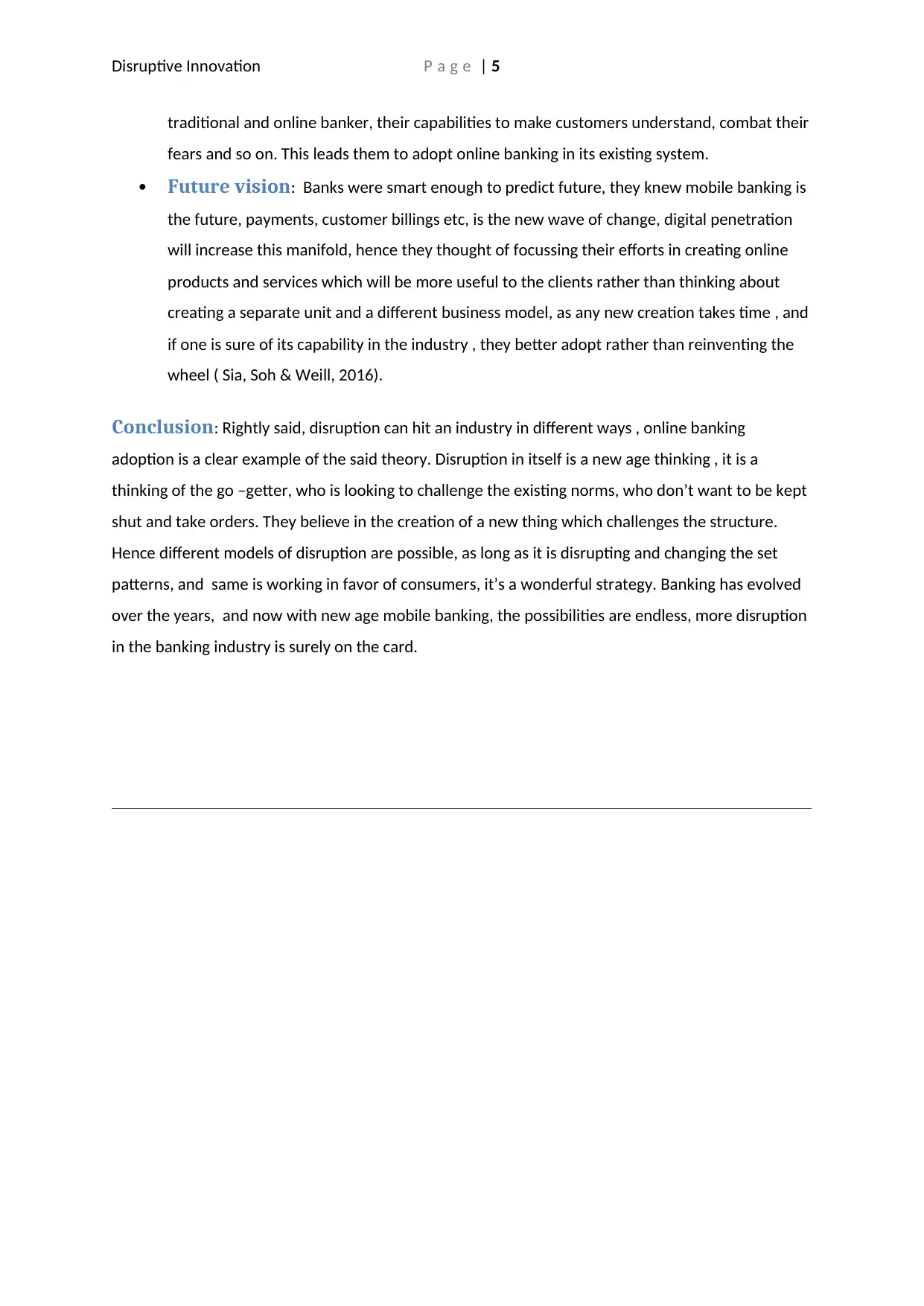
Disruptive Innovation P a g e | 5
traditional and online banker, their capabilities to make customers understand, combat their
fears and so on. This leads them to adopt online banking in its existing system.
Future vision: Banks were smart enough to predict future, they knew mobile banking is
the future, payments, customer billings etc, is the new wave of change, digital penetration
will increase this manifold, hence they thought of focussing their efforts in creating online
products and services which will be more useful to the clients rather than thinking about
creating a separate unit and a different business model, as any new creation takes time , and
if one is sure of its capability in the industry , they better adopt rather than reinventing the
wheel ( Sia, Soh & Weill, 2016).
Conclusion: Rightly said, disruption can hit an industry in different ways , online banking
adoption is a clear example of the said theory. Disruption in itself is a new age thinking , it is a
thinking of the go –getter, who is looking to challenge the existing norms, who don’t want to be kept
shut and take orders. They believe in the creation of a new thing which challenges the structure.
Hence different models of disruption are possible, as long as it is disrupting and changing the set
patterns, and same is working in favor of consumers, it’s a wonderful strategy. Banking has evolved
over the years, and now with new age mobile banking, the possibilities are endless, more disruption
in the banking industry is surely on the card.
traditional and online banker, their capabilities to make customers understand, combat their
fears and so on. This leads them to adopt online banking in its existing system.
Future vision: Banks were smart enough to predict future, they knew mobile banking is
the future, payments, customer billings etc, is the new wave of change, digital penetration
will increase this manifold, hence they thought of focussing their efforts in creating online
products and services which will be more useful to the clients rather than thinking about
creating a separate unit and a different business model, as any new creation takes time , and
if one is sure of its capability in the industry , they better adopt rather than reinventing the
wheel ( Sia, Soh & Weill, 2016).
Conclusion: Rightly said, disruption can hit an industry in different ways , online banking
adoption is a clear example of the said theory. Disruption in itself is a new age thinking , it is a
thinking of the go –getter, who is looking to challenge the existing norms, who don’t want to be kept
shut and take orders. They believe in the creation of a new thing which challenges the structure.
Hence different models of disruption are possible, as long as it is disrupting and changing the set
patterns, and same is working in favor of consumers, it’s a wonderful strategy. Banking has evolved
over the years, and now with new age mobile banking, the possibilities are endless, more disruption
in the banking industry is surely on the card.
⊘ This is a preview!⊘
Do you want full access?
Subscribe today to unlock all pages.

Trusted by 1+ million students worldwide
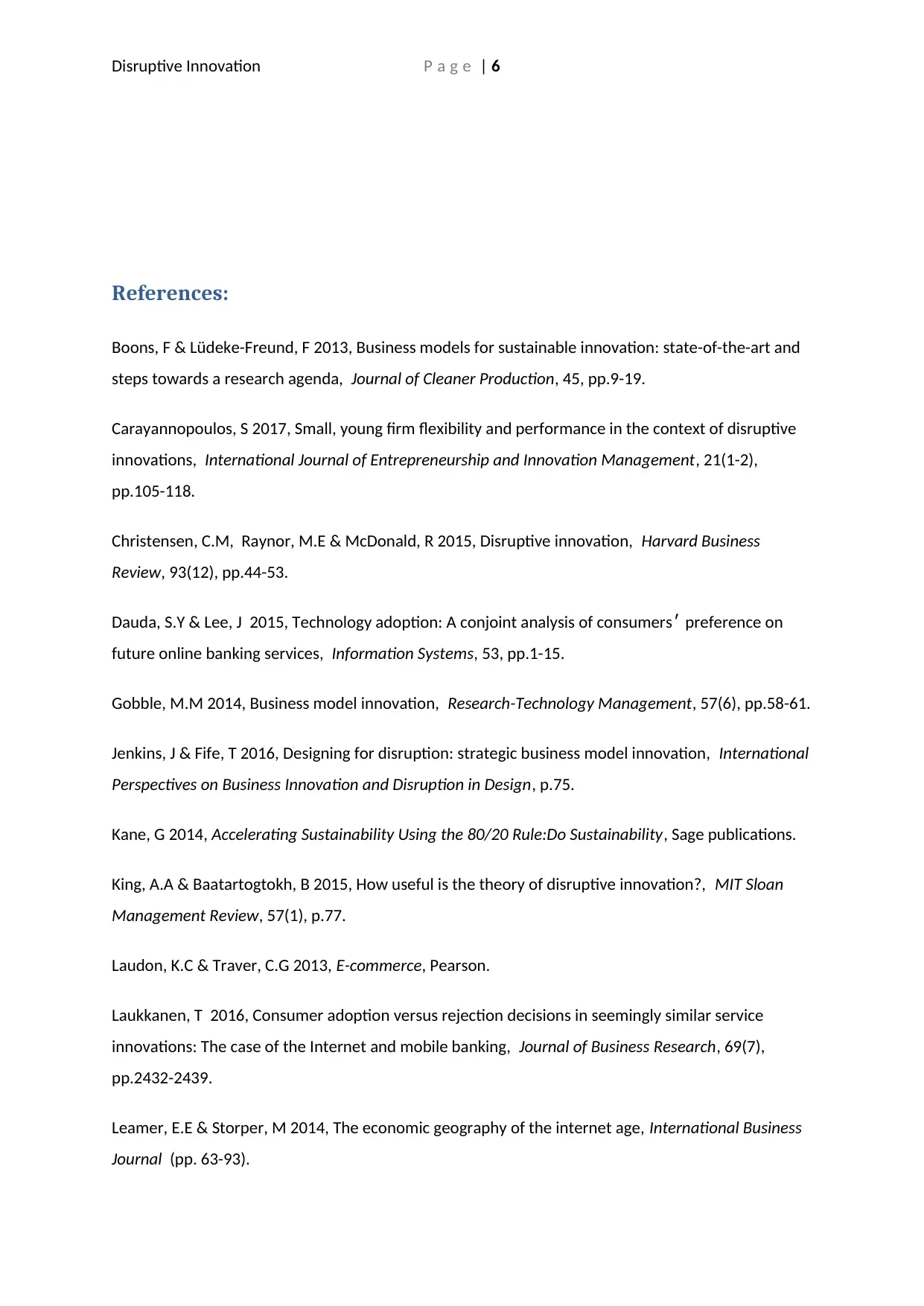
Disruptive Innovation P a g e | 6
References:
Boons, F & Lüdeke-Freund, F 2013, Business models for sustainable innovation: state-of-the-art and
steps towards a research agenda, Journal of Cleaner Production, 45, pp.9-19.
Carayannopoulos, S 2017, Small, young firm flexibility and performance in the context of disruptive
innovations, International Journal of Entrepreneurship and Innovation Management, 21(1-2),
pp.105-118.
Christensen, C.M, Raynor, M.E & McDonald, R 2015, Disruptive innovation, Harvard Business
Review, 93(12), pp.44-53.
Dauda, S.Y & Lee, J 2015, Technology adoption: A conjoint analysis of consumers׳ preference on
future online banking services, Information Systems, 53, pp.1-15.
Gobble, M.M 2014, Business model innovation, Research-Technology Management, 57(6), pp.58-61.
Jenkins, J & Fife, T 2016, Designing for disruption: strategic business model innovation, International
Perspectives on Business Innovation and Disruption in Design, p.75.
Kane, G 2014, Accelerating Sustainability Using the 80/20 Rule:Do Sustainability, Sage publications.
King, A.A & Baatartogtokh, B 2015, How useful is the theory of disruptive innovation?, MIT Sloan
Management Review, 57(1), p.77.
Laudon, K.C & Traver, C.G 2013, E-commerce, Pearson.
Laukkanen, T 2016, Consumer adoption versus rejection decisions in seemingly similar service
innovations: The case of the Internet and mobile banking, Journal of Business Research, 69(7),
pp.2432-2439.
Leamer, E.E & Storper, M 2014, The economic geography of the internet age, International Business
Journal (pp. 63-93).
References:
Boons, F & Lüdeke-Freund, F 2013, Business models for sustainable innovation: state-of-the-art and
steps towards a research agenda, Journal of Cleaner Production, 45, pp.9-19.
Carayannopoulos, S 2017, Small, young firm flexibility and performance in the context of disruptive
innovations, International Journal of Entrepreneurship and Innovation Management, 21(1-2),
pp.105-118.
Christensen, C.M, Raynor, M.E & McDonald, R 2015, Disruptive innovation, Harvard Business
Review, 93(12), pp.44-53.
Dauda, S.Y & Lee, J 2015, Technology adoption: A conjoint analysis of consumers׳ preference on
future online banking services, Information Systems, 53, pp.1-15.
Gobble, M.M 2014, Business model innovation, Research-Technology Management, 57(6), pp.58-61.
Jenkins, J & Fife, T 2016, Designing for disruption: strategic business model innovation, International
Perspectives on Business Innovation and Disruption in Design, p.75.
Kane, G 2014, Accelerating Sustainability Using the 80/20 Rule:Do Sustainability, Sage publications.
King, A.A & Baatartogtokh, B 2015, How useful is the theory of disruptive innovation?, MIT Sloan
Management Review, 57(1), p.77.
Laudon, K.C & Traver, C.G 2013, E-commerce, Pearson.
Laukkanen, T 2016, Consumer adoption versus rejection decisions in seemingly similar service
innovations: The case of the Internet and mobile banking, Journal of Business Research, 69(7),
pp.2432-2439.
Leamer, E.E & Storper, M 2014, The economic geography of the internet age, International Business
Journal (pp. 63-93).
Paraphrase This Document
Need a fresh take? Get an instant paraphrase of this document with our AI Paraphraser
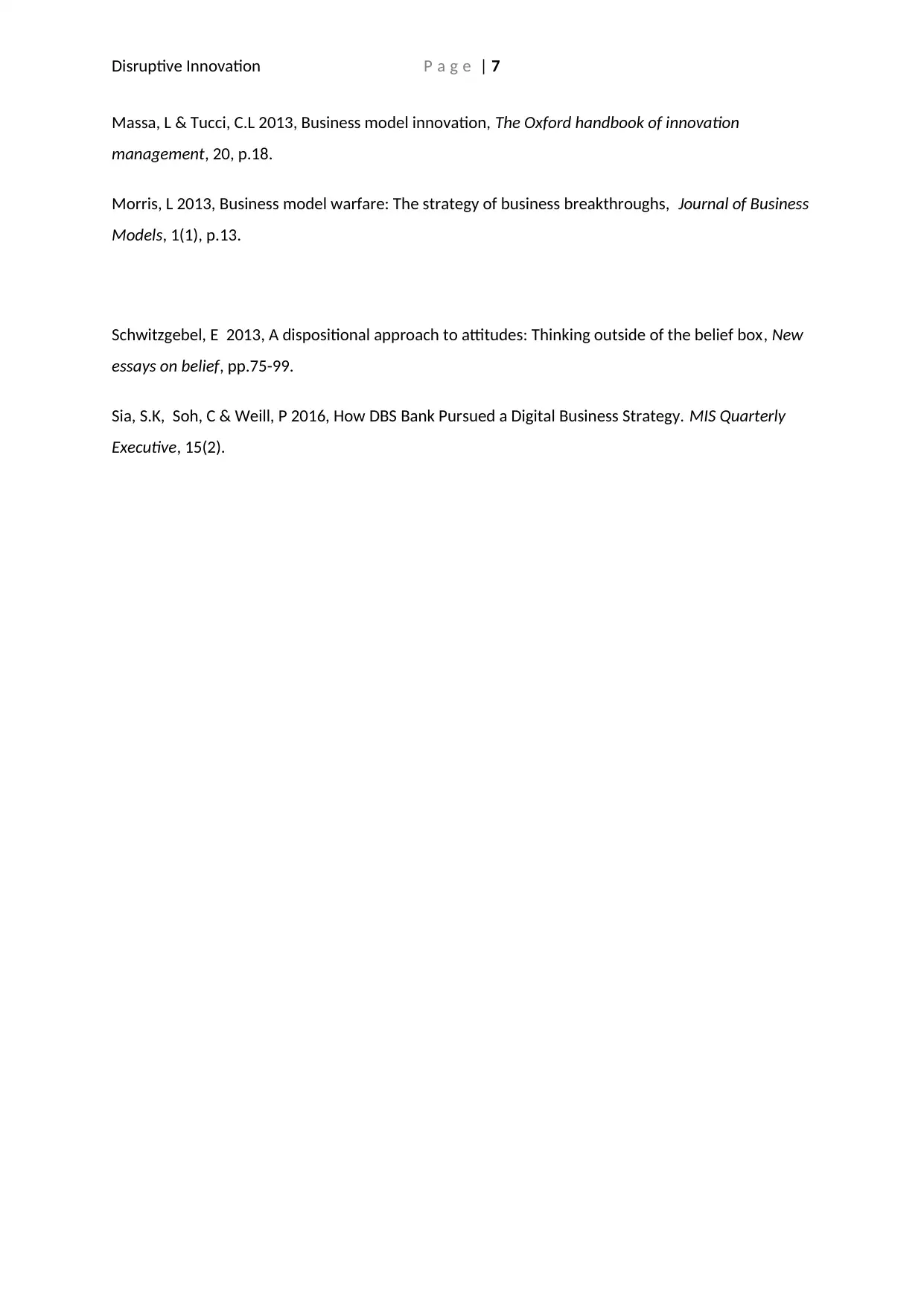
Disruptive Innovation P a g e | 7
Massa, L & Tucci, C.L 2013, Business model innovation, The Oxford handbook of innovation
management, 20, p.18.
Morris, L 2013, Business model warfare: The strategy of business breakthroughs, Journal of Business
Models, 1(1), p.13.
Schwitzgebel, E 2013, A dispositional approach to attitudes: Thinking outside of the belief box, New
essays on belief, pp.75-99.
Sia, S.K, Soh, C & Weill, P 2016, How DBS Bank Pursued a Digital Business Strategy. MIS Quarterly
Executive, 15(2).
Massa, L & Tucci, C.L 2013, Business model innovation, The Oxford handbook of innovation
management, 20, p.18.
Morris, L 2013, Business model warfare: The strategy of business breakthroughs, Journal of Business
Models, 1(1), p.13.
Schwitzgebel, E 2013, A dispositional approach to attitudes: Thinking outside of the belief box, New
essays on belief, pp.75-99.
Sia, S.K, Soh, C & Weill, P 2016, How DBS Bank Pursued a Digital Business Strategy. MIS Quarterly
Executive, 15(2).
1 out of 8
Related Documents
Your All-in-One AI-Powered Toolkit for Academic Success.
+13062052269
info@desklib.com
Available 24*7 on WhatsApp / Email
![[object Object]](/_next/static/media/star-bottom.7253800d.svg)
Unlock your academic potential
Copyright © 2020–2025 A2Z Services. All Rights Reserved. Developed and managed by ZUCOL.





